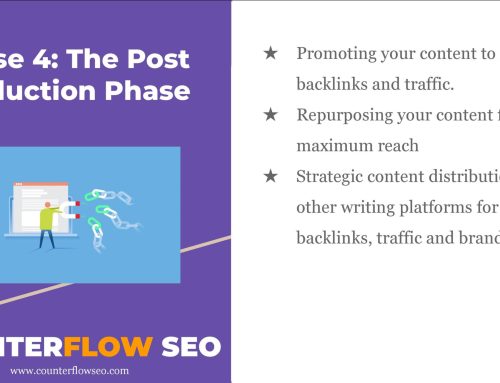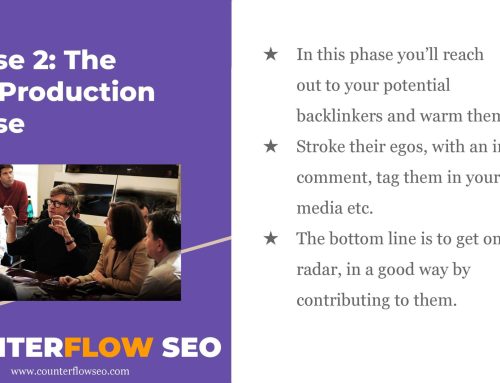If you haven’t read the overview section yet, I highly encourage you to do so before reading further, as this page builds on top of the information shared in the overview section.
The Phase 1 of Counterflow SEO Strategy is all about research.
You must have heard of terms like “keyword research”, “topic research” etc, thats precisely what we are doing here.
However, unlike traditional keyword and topic research, where you choose a topic out of thin air or Google trends and find low competition keywords around that topic, we are doing things more strategically.
How Traditional SEO Advice Is Flawed?
Traditional SEO advice goes something like you should write your content for your readers, and if you write value-packed content for your readers, Google will mystically magically rank you higher.
At first, when I heard this advice, I had a lot of questions and one of them being, how does Google know that if a reader of my blog post actually liked that content?
Also, where will I find these readers who would supposedly like my content, to get higher rankings on Google?
I didn’t get clear answers to it, because SEO doesn’t quite work that way.
It is because of this reason, as counterflow (pun intended) to popular belief that we won’t be writing content for our target audience, instead we will be writing for our backlinkers.
In other words, we will be writing content for people who can link to your content, because they have the power to link to you, driving more traffic to your site.
Why? Because Google considers the amount of other websites that have linked to your site as a major factor of ranking on Google, a.k.a, backlinks.
Here is a simple implementation of this in the entertainment industry.
Late night talk shows hosts like Jimmy Falon, Stephen Colbert, Jimmy Kimmel etc, act exactly like backlinkers.
You see, for example, when celebrities like The Rock want to promote their movie or any product for that matter, their agents reach out to these late night show hosts to promote it.
In other words, The Rock is able to reach his fans and more new audience that these late night show hosts have by collaborating with them.
Similarly, by writing content for your backlinkers, your content has the potential to get readers from your backlinker’s audience because they are linked to your site.
Additionally, each backlink from multiple backlinkers is a positive sign for Google ranking which translates to more traffic.
To drive this concept even further, I found a very similar approach being mentioned by Russell Brunson in his book Traffic Secrets, where he talks about the concept of Dream 100.
Much like the late night talk show hosts, Dream 100 has access to alot of people, you approach them to help you promote your content to their audience, which gets you more eyeballs to your content.
However, approaching them is a skill, which we’ll cover later on in the article.
Now that we have emphasized on why you should be writing content for your backlinkers rather than your target audience, now I’ll show you the step by step process to finding your backlinkers.
How To Find Your Backlinkers?
Step #1: Google Informational Keywords
Imagine yourself as a student of a niche you have chosen for your blog or website, and think what keywords you would enter in Google to get information related to the niche.
For eg: let say I want to create a blog on fat loss.
I’m actually on a fat loss journey myself so this would be ideal.
My information keyword may look something like
- Fat loss tips
- Ways to lose fat fast
- Getting rid of stubborn belly fat
You get the idea!
Once you have searched for these keywords, note down all the websites you get as results.
Step #2: Google Specialized Keywords
Google is probably the most underrated SEO tool on the planet, because of the wealth of information it has waiting to be tapped into, using the right keywords.
These are keyword formats your average Joe Schmo Google user doesn’t use and mostly used by marketers and SEO professionals.
Using these keyword formats below on Google, you’ll be able to get the real power of Google as an SEO tool.
- “[keyword] blogs to follow”
- “best [keyword] blogs”
- “best [keyword] posts [year]”
- “top [keyword] blogs to follow” + [year]”
What you basically do here is to replace the [keyword] with your informational keyword.
Informational keywords are basically keywords that your average user would potentially enter on Google to get some info on a topic, i.e, learn about some topic. Hence, “informational”
Based on our example, that would be
- “Fat loss blogs to follow”
- “Best fat loss blogs”
- “best fat loss posts 2022”
- “top fat loss blogs to follow” + “2022”
At this step, what you do is basically get each of these keyword search strings and do a google search without the quotes.
Much like the previous step, note down all the websites you get as results.
Step #3: Backlink Drilling
This is where things get interesting.
Once you have followed Step 1 and Step 2, you will have a list of all potential backlinkers for your website.
In this step, you are actually drilling for more backlinks, by which I mean you are finding out the backlinkers who your current list of potential backlinkers are getting links from.
Unlike the other steps, you would do this in a Keyword Tool like Ahrefs, Semrush or SerpStat etc, which would cost you a couple hundred dollars.
The benefit of this step is obviously, more potential backlinkers to focus your content towards, giving you more certainty for the success of your content, which means more backlinks.
Now that you have a strong list of backlinkers to write your content for, the next step is to find the right topic to write your content on.
How To Find The Right Topic?
In the past whenever I sat down to write a blog post, I have always had this gnawing question in my head, “What do I write about?”
Even if I do pick a random topic, the entire time while I write, I used to have a lot of self-doubt whether all the time I’m spending is useless, because I didn’t have any assurance that the topic I chose to write the article on is the right one in terms of getting Google rankings.
As I attended alot of meetups and content marketing events, I found that many people faced the same obstacles, but they relied on will power to get through the writing process to overcome the self-doubt.
However, this didn’t work well for me. I like to work smart, as much as I love to work hard.
In this section of the article you will learn how to find the right topic that your backlinkers will love, get links and organically help you get ranked on Google.
Step #4: Backlinker’s Topic Research
From steps 1, 2 and 3 we have made a list of backlinkers we need to appeal to, so that we can get backlinks from them.
The best way to appeal to them is to write content based on a topic that they are also interested in.
For this reason, we would visit each of the backlinker’s websites and note down 2 to 5 topics that each of them tend to write about.
This also gives us a fingertip feel for the backlinker’s writing style, aesthetic taste, and alot of other intangibles like that.
Step #5: Topic Research Using Google
Much like previously, Google can also be leveraged for finding out topics that your backlinker’s might also be interested in linking to.
For this purpose, we want to use special Google keyword formats like below,
- “keyword” + inurl:links
- “keyword” + intitle:resources
- “keyword” + “helpful resources”
- “keyword” + “useful resources”
Once you enter the keywords into Google, look for the topics that come up quite often in the search results.
The titles and description will give you an indication of the title that the backlinker is focusing on.
Note down these topics for each keyword format string.
Step #6: From an SEO Tool
By now we should have a healthy list of topics that we can use to write the article, however, we can go just a little bit deeper into the search.
You can use an SEO tool like Ahrefs for this step.
For each of potential backlinkers in your list, you can look up the Top pages of the site to get an idea on what Topics they tend to write alot about.
This helps us become more focused with our research.
Armed with the backlinkers and their topic of interest, we have one last research to do in this phase.
That is Keyword Research.
How To Do Keyword Research The Right Way?
In this section, there is a common myth that I want to debunk.
When it comes to keyword research, most of the advice you hear online is to find long tail keywords and write articles around this specific keyword.
The argument is that long tail keywords have low competition and hence are easier to rank on Google to get traffic.
However, here is the problem…
With the Google algorithm update named, Rank Brain, Google is now able to understand the intent behind your content.
This means that if you write 2 articles, with two different long tail keywords that have the same intent, Google is now able to see that both the pages convey the same information.
For example, if you write one article for “react agencies in melbourne” and another one for “melbourne react agency”, Google knows these two pieces of content have the same information.
Furthermore, when you focus on writing content around a specific long tail keyword, you will have to write a LOT of content to rank on Google.
This is not good, because having to write a lot of content puts a lot of cognitive stress on you which would reflect in the quality of your article.
To make things worse, the more content you have on your website, the more diluted your link authority becomes even if you do get Google rankings for a keyword.
In short, writing articles around long tail keywords is not the most optimal way to approach your SEO.
So, the solution? Medium Tail Keywords.
Unlike long tail keywords, medium tail keywords have moderate levels of competition.
When you write an article around a medium tail keyword, you organically use many of the long tail keywords which are associated with the medium tail keyword without writing more and more content, which as we learned, dilutes your link authority.
Medium tail keywords give you more room to express your ideas, instead of being too specific to the topic.
Does that mean long tail keywords are bad? Absolutely not..
Long tail keywords…because of it’s specificity, are best utilized on product display pages or PDPs as they say in the eCommerce industry.
Pro tip: If you are into eCommerce, consider writing a long page article with a medium tail keyword on a backlinker friendly topic and link it to your Product Display Pages which are optimized for long tail keywords. 😉 #FreeAdvice
Here is how we find out the medium tail keywords related to your backlinker friendly topic.
Step #7: Enter A Topic Related Keyword
In this step, we choose a topic from the backlinker friendly topic list and enter it into an SEO tool.
This SEO tool can be anything like Ahrefs, SEMRush etc.
This tool will give you alot of keywords related to the topic with Search Volume info for each of them.
Step #8: Choose The Right Keyword
Sort the results based on the search volume info and choose a keyword from the middle of that list.
No matter how you have sorted the list by search volume, you can always rely on a keyword that is approximately in the middle of that list.
Conclusion
In this article, we have covered
- How traditional SEO advice is flawed
- Why you should be writing content for your backlinkers rather than your readers
- How to find your backlinkers
- How to choose the right topic for your content, instead of relying on Google Trends
- Why relying on long tail keywords is not optimal for SEO
- How to do proper keyword research for your content
Also. by the way, if you are interested…
In the next phase, we are going to engage in a practice that 99% of bloggers skip.
Click the button to find out more…





Leave A Comment